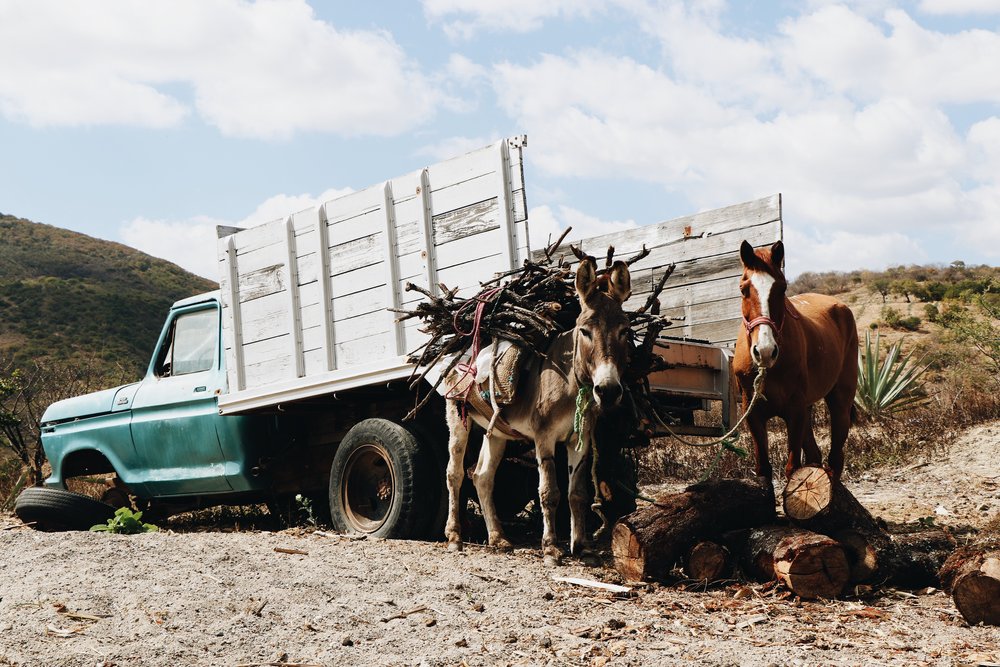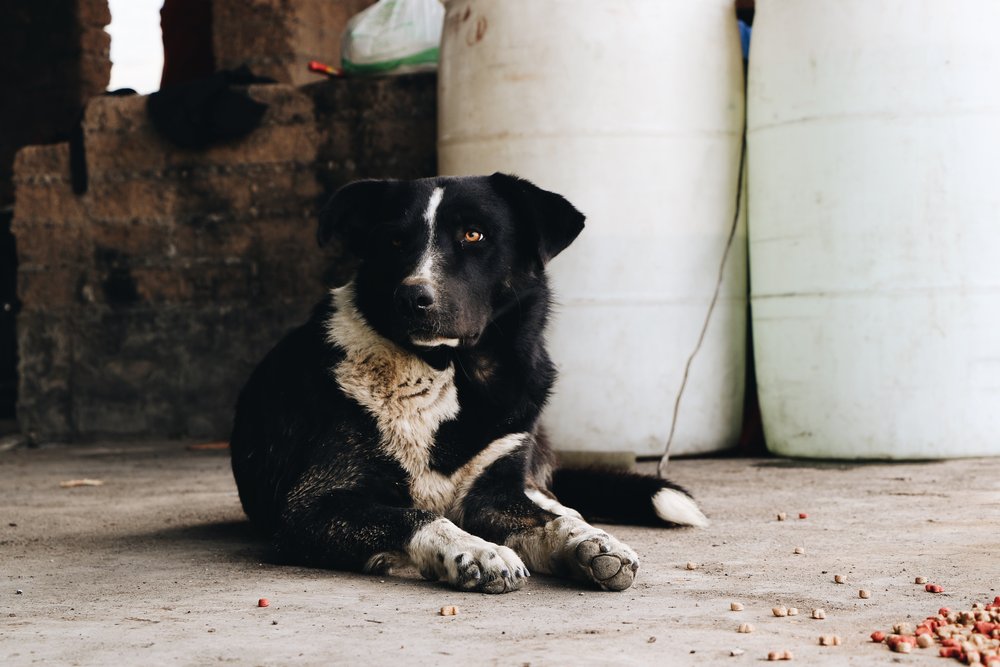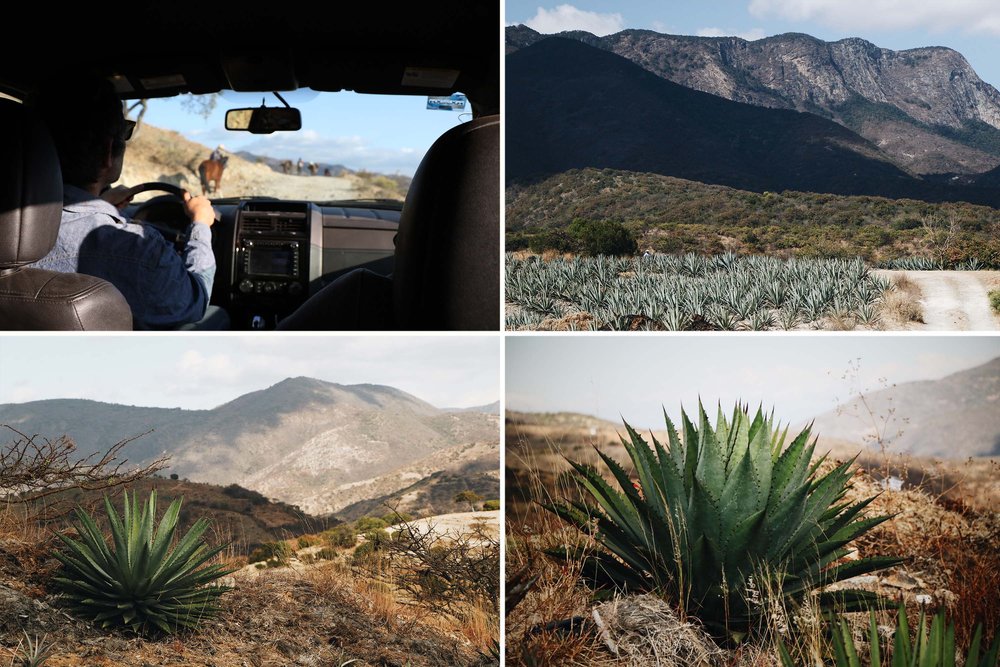.gif?format=1500w)
There’s a story in Clarissa Pinkola Estés’s seminal book, “Women Who Run With the Wolves,” about an old crone who wanders the desert gathering animal bones. Her name is La Loba, the wolf woman, or sometimes La Huesera, the bone woman. Once she’s collected an entire skeleton, she conjures up a fire and sings a song to flesh out the armature with thick fur until a wolf springs forth from the flames. The animal morphs into a woman who runs free and wild back into the night. La Loba’s primary mission, Estés explains, is to “collect and preserve especially that which is at risk of being lost to the world.”

I was reminded of La Loba during a reporting trip to Mexico in January, when I spent the day watching Leo Hernández make mezcal in San Baltazar Guelavila. Perched high on top of a small mountain in the Sierra Madre Sur, his new distillery bears the marks of fresh construction, but his methods cast a line back through history. As a descendant of Oaxaca’s indigenous Zapotec people, and a fifth-generation mezcalero, Leo conjures spirits the same way his ancestors have done for a century before him.
Mezcal is one of the world’s oldest and most storied distilled spirits, with a genealogy that traces back at least 300 years in Mexico. Yet today, the historic traditions that defined the category are at risk of disappearing as the industry grows at a furious rate. As foreigners clamor for a taste of this marvelous, soulful liquid, and international brands and behemoth conglomerates vie for a piece of the gold rush, their relentless march is having a detrimental effect on the ecology and culture of mezcal.

That is why—with La Loba’s directive beating in my chest—when I go to Mexico to visit mezcal producers, I am always most interested in observing and learning from those who fight to keep heritage at the forefront of their production, like Leo does, his methods pulled deep from the folds of time.
BEARING WITNESS
Leo likes to say that his only neighbor up here is God, my new friend Catherine tells me as we ride up the last stretch of rocky road in her beat-up SUV, her eyes shining back at me in the rearview mirror.
I met the good-natured freelance writer for the first time this morning, when she and her partner Victor—expats from America and Spain, respectively—picked me up at the hotel. Prior to this meeting, I had heard nothing about Leo and Victor’s mezcal brand, Grulani, and I had only exchanged a few emails with Catherine. After the 90-minute drive from Oaxaca’s city center to the village of San Baltazar, I feel nothing but relief and a swelling sense of excitement; it’s clear they are good, salt-of-the-earth folks.

As we pull up to the palenque (the Oaxacan term for distillery) via a long dusty road flanked by fields of statuesque agaves, I look out over the vistas and notice there is not another building in sight for miles, save the village at the bottom of the mountain. It really does feel like a holy place.
Right away, as I get out of the car, I’m greeted by a warm breeze carrying the aromas of production. It’s a heady mix of smoldering encino negro, a rough-barked wood that smells like toasted morita chiles and burnt ends, mingled with the scent of cooked agave, all ribbons of amber honey, apple butter, roasted sweet potato, and brittle toffee. I surrender, letting my agenda, timetables, and to-do lists float away.
Leo is already hard at work, scooping out agave fibers from the molino, the stone mill where the cooked plants are pulverized to make them more manageable for the fermentation tanks. When I heard the words “fifth-generation mezcalero” in the car, I didn’t expect the producer to be my age, and I’m a little surprised to find out he is a youthful 37 years old.
A quick COVID-era fist bump allows me passageway into the palenque—then Leo goes right back to the job at hand. Victor unloads a wide, shallow pan from the trunk with plans to make paella for lunch, while Catherine says hello to Leo’s 12-year-old son, Juanito, who seems decidedly uninterested in her attention. A dusty, black-and-white tuxedo dog growls, warning us newcomers to keep our distance, and the rest of the distillery crew carry out their respective tasks, stoking the fires under the still, chopping cooked agave into smaller chunks for shredding, and sniffing the fermentation vats to make sure things are bubbling along the way they should.
Right away, as I get out of the car, I’m greeted by a warm breeze carrying the aromas of production. It’s a heady mix of smoldering encino negro, a rough-barked wood that smells like toasted morita chiles and burnt ends, mingled with the scent of cooked agave, all ribbons of amber honey, apple butter, roasted sweet potato, and brittle toffee.
I’ve been on distillery tours around the world, and it’s immediately clear that today will not be a distillery tour. There is no guide waiting eagerly with a wide Cheshire grin, no detailed itinerary to keep, no wining and dining on the agenda. Not that I mind—what keeps me most engaged are the days where I get to watch something organic unfold without someone in my face trying to tell me what to write or think or watch. I’m just here to bear witness.
As I float around with my Canon, snapping photos, I notice one of the palenqueros (distillery workers), stern-faced Leandro, giving me an annoyed side-eye, like I’m a fly buzzing in his ear. He lifts up his shirt to wipe sweat from his brow, revealing an impressive beer belly. I resist the urge to lift my camera in turn. I am not here to get in his way, and he is not here to perform, so I meander away from the sounds of the rakes and shovels grinding against stone and cement and head towards the edge of the property to check out the view.

From the top of this mountain, the hills and valleys beyond stretch out into the distance like waves. A calm morning light ripples across them. A red-tailed hawk soars above searching for its next meal, and the far-off whinny of Leo’s salty old donkey tickles my ears. January is the “cold” season in Oaxaca, but I know there is a foot of snow on the ground back home in Michigan, so I relish the 76° wind that ruffles through the dried scrub brush at my feet.
Below, a myriad of agave varieties dot the hillside. Young, brash espadín screams up from the soil with sword-like spikes aimed towards the sky. In contrast, the petite tobalá crawls out of the earth with a soft beauty that turns a touch sinister when you get close enough to notice the blood-red teeth that jigsaw out of its curvaceous leaves. Every maguey has its own agenda—its own fingerprint and personality—many soaking up the rain and sun for decades before coming to maturity. What wisdom have they collected through so many nights and mornings, so many Januarys and Julys?
SWIMMING AGAINST THE TIDE
In her book, Estés writes that when La Loba sings over the bones she has collected in the desert, she is pouring soul over something that needs to be restored back into vital shape. Mezcal doesn’t need to be resurrected or repaired—the spirit has long been present in the rural communities of Mexico, serving and nourishing the people who hold the agave plant at the center of their culture—but its customs and culture do need to be safeguarded.
Traditional mezcal is the slow food of the spirits world. What makes it unique and special is the time and wisdom it takes to produce it. Agaves can take decades to come to maturity. Getting the plants to the distillery demands herculean efforts. Fermentation sometimes stretches on for weeks before the vats stop frothing. From start to finish, every batch takes Leo almost an entire month to make. Within the layers of those timetables, you can get lost in the wonder of the process.

Traditional mezcal is also, in its purest form, an organoleptic thing made with hands and heart—not a product of industrial mechanisms and machines. A savvy bartender I interviewed once said, “It’s techniques, not technologies.” The stewards of this spirit must work in tandem with the earth and its natural processes to make mezcal in a way that reveals its true nature. From burying the magueys deep in the earth, so they caramelize slowly over smoldering coals, to kickstarting the untamed alchemy of natural fermentation, where the yeasts and microbes carry out their work in a frenzy, mezcaleros learn to gauge and harness each step by sight, sound, and smell.
Mezcaleros face increased pressure to produce higher volumes, cheaper, with more efficiency. To churn out a consistent product at a pace that puts unreasonable demand on the environmental resources—the agaves, water, wood—needed to make the juice, and in a manner that discourages the intuitive, unhurried methodologies that have persisted in mezcal-making communities for centuries. All of these requirements dilute the culture and strip the liquid of the characteristics that make it unique in the first place.
The process reminds me of learning how to make biscuits from your mother or grandmother. There is no recipe sketched out on paper. No precise formula to follow. Instead, you have to spend time with her, watch her knead the dough, judge how much water to add and when, and commit these sensory touchpoints to memory. You learn, you carry on, and you teach the next generation how it’s done. It’s timeless. Universal.
All of that stands in contrast with the mezcal industry’s explosive, even pernicious growth. Mezcaleros face increased pressure to produce higher volumes, cheaper, with more efficiency. To churn out a consistent product at a pace that puts unreasonable demand on the environmental resources—the agaves, water, wood—needed to make the juice, and in a manner that discourages the intuitive, unhurried methodologies that have persisted in mezcal-making communities for centuries. All of these requirements dilute the culture and strip the liquid of the characteristics that make it unique in the first place.
This fraught trajectory has producers and enthusiasts alike concerned about what the future holds, but thankfully, in this current and precarious moment, you can still find distillers swimming against that seemingly inevitable tide, making mezcal in an organic way and using sweat equity instead of quick shortcuts. Mezcaleros like Leo, who hold guard over customs and conventions so they will endure for future generations. The only difference between how he makes the spirit now and how his family has produced mezcal for ages is that he and his crew carry cell phones, drive pick-up trucks, and wear baseball caps. The specific steps of production stay preserved in amber.

Back in the palenque, it’s time to taste some of the fruits of the workers’ labor. Catherine pours me a mezcalito of tobasiche, a stubborn agave from the karwiinski family that is endemic to Oaxaca. The plant has a long, thick trunk like a rugged baseball bat, with spiky pencas that explode out of the top, kind of resembling a yucca, or Beaker from the Muppets. It takes about a decade to come to maturity before it can be harvested and processed into mezcal, and Victor informs me that it is also Leo’s specialty. The flavor is explosive, a vibrant mix of sweet cedar and tarragon, rippling over wet river rocks.
In the moment, I stop trying to come up with the right words to describe the mezcal as one of the palenqueros, Tomas, ambles over and pulls up a red plastic lawn chair near the bottles. He’s the oldest gentleman of the crew, missing most of his front teeth, and he is eager to share his English with us gringas. He spent more than a decade living in Los Angeles, he says, before asking Catherine to pour him a mezcal with Coke. She smiles politely and turns an amused look in my direction as my eyebrows shoot up in quiet surprise.
I imagine the gasps of horror that would reverberate throughout various social media forums if the agave purists were there to witness it. Mezcal and Coke. I can almost hear their dogma on full volume from a thousand miles away. I shrug and allow a big grin to spread across my face. Who am I to have qualms? I am just a visitor here. The man has been working hard all day—he deserves to drink the fruits of his labor however the fuck he wants.
OBSERVING FROM THE MARGINS
The paella is ready—“a beautiful fusion of our cultures,” Victor says, drizzling the last bit of olive oil from a plastic water bottle over the heaping pile of rice, and ushering everyone to dig in. The rest of the palenqueros wrap up their tasks and join us. Leo is shadowed by Juanito, who has followed his dad around all day, quietly and seriously watching and learning the family trade.
Leo began his own mezcal journey around Juanito’s age, cutting agaves at 14 and shadowing his father Cosme for another six years before starting to produce his own mezcal. In between bites, I ask him how it feels to know that his legacy will carry on with Juanito. He pauses for a moment before answering. “I wasn’t taught by my father. I don’t teach my son. We watch and learn,” he tells me with a reflective look that suggests a soft swelling of pride. “It’s part of our culture, our heritage. It’s in our blood.”

Earlier in the day, I watched Juanito smell the agave fibers in the fermentation tank and wondered if his grandfather had done the same thing so many decades ago, and how they might resemble one another, their behaviors and bodies overlapping across time. I think about the amassing of heritage knowledge on a larger scale, throughout the entire mezcal industry. In my mind’s eye I see sons and daughters watching their fathers and mothers and older brothers hollow out the earthen cooking pits and sense when cuts need to be made in the distillate. Maybe the ghosts of their ancestors are there, too, observing from the margins.
In between bites, I ask him how it feels to know that his legacy will carry on with Juanito. He pauses for a moment before answering. ‘I wasn’t taught by my father. I don’t teach my son. We watch and learn,’ he tells me with a reflective look that suggests a soft swelling of pride. ‘It’s part of our culture, our heritage. It’s in our blood.’
It’s easy to romanticize the whole thing, and I often worry about striking the right balance between capturing the poetic beauty of the process and keeping the narrative anchored in reality. Consumers want mezcal fast and cheap, ready packaged and digestible. That’s not a surprise to me—us Americans are incentivized to gobble up other cultures instead of sitting in the glow of them, observing respectfully and without interference. We’re praised for checking the boxes of travel bucket lists instead of sharing a mezcalito with another human being and listening to their stories. We’re encouraged to uphold the implied doctrine that slow and quiet regard is nothing when you can just devour something whole.
I grew up in the United States, so whether I like it or not, those values are branded deeply into my skin. The internalized impulses that come with them are ever present, and avoiding the commodification of culture requires an active awareness. I’d rather spend my time tapping into a time and place where traditions are carried out without fanfare, where intuition and community take precedence over consumption, like the slow reflective quiet of making biscuits with grandma. A place where the She Wolf in the desert never shriveled to dust and bone in the first place.
I particularly struggle with how to consolidate those conflicting inclinations when it comes to the reporting I do in the mezcal realm. Can stories about traditional mezcal made by people like Leo help us examine, question, and perhaps unravel or challenge shallow appetites? What can traditional mezcal teach us about the power of endurance and quiet introspection? About the need to foster and maintain deep relationships with our family members and our communities?
And what happens if these stories are not told? Is there a way to encourage people to pay premium prices for traditional mezcal the same way they do with Scotch or Japanese whisky, so that mezcaleros are encouraged to keep their heritage alive in the face of pressure to streamline? Surely that would preserve customs while also making sure mezcaleros make a solid living?

I also have to consider my role here as the visitor, the observer. I think about the size and shape of the footprint I leave in my wake in these communities as an outsider who flies in to observe and document. Am I complicit in fueling this faster, cheaper economy? Am I unintentionally making the whole category look more appealing to foreign investments, like setting a mouse trap with a bit of garish orange cheese? My intention is to fan the flames of these stories until they stand fully fleshed and run off feral into the world, but does that result in more harm than good?
This endless stream of mental negotiation feels nearly impossible for a single person to untangle. Then I remember the sage advice of those who live and breathe mezcal. On several occasions mezcaleros have told me that the key to understanding the spirit is to stop trying to unpack or name the kaleidoscope of flavors one finds in each sip, like sommeliers do with wine. It doesn’t matter if a bottle of tepeztate has more “green” notes than the floral ones often present in a tobalá. Keeping a detailed record of tasting notes for every bottle you’ve ever encountered is not the point, because getting buried too deep in the intellectualization of the spirit puts you further away from its heartbeat.
Instead, one should navigate the understanding of mezcal with more intuition, the way the spirit itself materializes in the world. I tell myself maybe it is okay not to have all the answers, to still my inner dialogue and let my senses guide the way. The imperative is listening to the people who make the spirit, watching and learning about what is important to them, and aiming to tell their stories with compassion and integrity.
LINGERING ON THE BORDERS OF MEMORY
My train of thought is interrupted: The day is waning, and it’s time for a team portrait before we head out.

I take entirely too long to fiddle with the settings on my Canon, and when I look back up, the whole crew has gathered next to the tahona, the colossal wheel made of stone used to crush agave hearts. Victor puts an avuncular arm around Juanito. Leo throws a “thumbs up” in my direction. Tomas is missing, though perhaps he’s just settled in with his mezcalito y Coke in the shade of the palenque. Leandro almost cracks a smile, and the grumpy dog who spent the better part of the day ignoring everyone decides to join the party unprompted; with head and tail poised high, he’s clearly proud to be part of team Grulani.
After we get the shot, the palenqueros head down the long dirt road back to the village on foot. Leo will return after sunset for the next steps of production, I’m told, as those of us bound for Oaxaca City pile back into the SUV. Mezcal waits for no one. It demands around-the-clock care and attention.
Catherine and I are “windows down” kind of women, so both of us have arms hanging out, hands sailing in the warm air. Halfway down the hill we have to pause for a herd of rambunctious goats and their weathered shepherd to clear the way. Catherine puts on a playlist that matches the mood so perfectly I sneak out my iPhone to Shazam it so I can revisit the golden vibe later.

My mind wanders back to earlier in the day, when she told me that Leo says his only neighbor is God. I am not a religious person, but the sentiment rattles around in my ribcage as we drive. The soul of mezcal thrives in holy places like this. To the palenqueros, it probably felt like another normal day at the ranch, but for me something sublime happened at the distillery on the top of the world. Something that ties the next generation back to ancestors that linger on the borders of memory. Something that begs the world to stop and slow down and appreciate the value in the way things used to be done.
Something worth respecting and preserving, before it’s lost to the world.
